Do you think gardening while full-time RVing is impossible?
Think again! With the right products and guidance, you can easily garden on the go.
As an avid gardener in my pre-RV life, I really missed having bright flowers, homegrown veggies, and fresh limes for my cocktails when traveling.
I finally began my RV garden and put everything I learned in this guide that highlights:
- The best plants for RV life
- Ideal RV gardening products
- Tips for travel days
There’s no need to give up gardening when you RV, so check out the info below!
Best Plants for RV Life
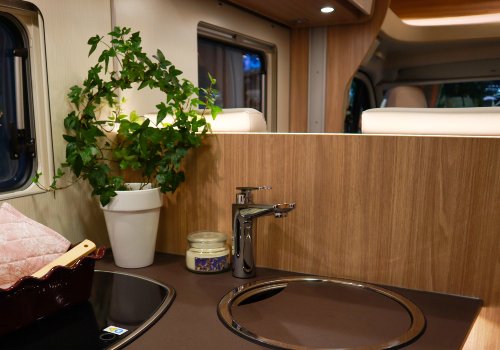
Once I tried doing some RV container gardening, it inspired me to keep expanding my selection and finding better ways to transport my little “garden family” safely to a new destination.
I did learn that some plants fare much better in a container over others such as:
- Palms
- Perennial Flowers
- Tomatoes
- Lettuce and Herbs
- Peppers
- Citrus trees
Let me suggest specific varieties that perform well and are low maintenance yet are suitable for smaller spaces.
Palms
Nothing spices up a campsite patio more than a palm tree or two. I always have one in my garden collection, and when it gets too big for my largest pot, I donate it and plant it at a campground in a southern climate where it can thrive.
Palms grow slowly so that you can keep one plant around for a long time.
You can shop for small palms locally, but my best-performing palm has been a Windmill variety from an online order sent directly to my campsite as a mere seedling.
The best-performing varieties are:
- Windmill Palm
- Majesty Palm
- Pygmy Date Palm
- Manila (Christmas) Palm
- Foxtail Palm
Palms don’t need unique soil but do need the occasional hit of Dr. Earth Exotic Blend fertilizer to give them the nutrients they need.
Do be aware that palms need to stay above 45°F to remain healthy, so don’t get a variety with a large canopy if you’ll need to bring it inside your RV occasionally to offer protection.
WARNING: Don’t get a Sago variety of palm. The Sago plant is toxic to animals if they chew on the leaves, and the leaf spines are incredibly sharp!
Best pot type and size for palm trees:
Most palms do well in a pot three inches wider in diameter than the one they grow in at purchase. Try to have the pot be at least 16-18 inches tall.
Choose a round pot that’s cylindrical and straight all the way to the ground. A pot that tapers at the bottom will not be as stable when the wind catches the palm canopy and can topple over.
Perennial Flowers
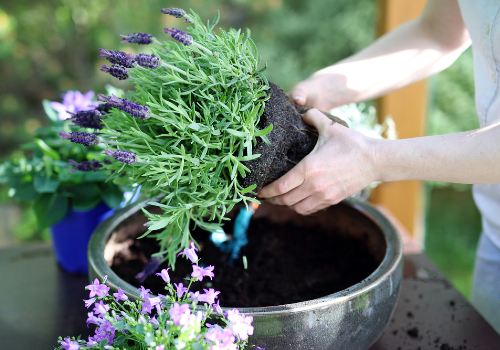
Annual flowers give instant satisfaction, but replanting every season gets expensive and tiring.
I find selecting a perennial variety of flowers in vibrant colors brightens up your campsite on even the dreariest of days.
Select varieties that are very tolerant to a range of temperatures for a high success rate and less worry when temperatures plummet unexpectedly.
The best-performing varieties are:
- Dianthus
- Bellflower
- Tickseed
- Cranesbill Geranium
- Heuchera ‘Electric Plum’ (Coral Bells)
Dianthus is by far my favorite flower choice. It does well in any size pot, can tolerate extreme heat and cold, and comes in a wide range of colors.
During this last history-making deep freeze in the south, my dianthus blooms didn’t even discolor, let alone die after they were left out in the bitter cold.
Best pot type and size for flowers:
One-gallon-size self-watering pots are excellent for flowers, and if you fertilize them regularly, you can maintain containers crammed full of blooms that look stunning.
If space is tight, but you still crave a variety of flowers, try a stackable tower planter. I just started using this type of planter, but I love it and will be purchasing more to streamline my RV garden.
Tomatoes
Compactor bush cherry tomatoes are best for RV gardening as the fruits aren’t so heavy they could break off during travel from bumps and vibration.
The tomato plants also have a shorter growing season and provide an excellent bounty that’s perfect for a couple or small full-time RV family. The best part is if you have too many, you can make friends with camping neighbors by giving them away.
These are my favorite cherry tomato varieties:
- Small Fry
- Tiny Tim
- Patio Pik
- Golden Nugget
- Early Cascade
Consider staggering planting between two pots for a consistent crop of juicy, flavorful tomatoes.
Best pot type and size for tomatoes:
A 5-gallon glazed clay pot is best, but a self-watering, heavy-duty plastic container also does well to keep thirsty tomato plants happy. I use a tomato cage trellis to help support the plant while it grows and during travel.
Lettuce & Herbs
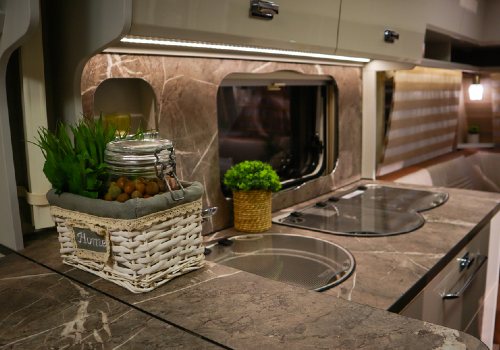
For salad lovers and RV chefs, having an abundance of fresh lettuce and herbs makes every meal more healthy and delicious.
Growing lettuce and herbs is easy when you keep them out of too much direct sun. You can keep snipping leaves off herbs and many lettuce varieties for weeks or even months, and new ones will regrow, which means you can avoid buying them from stores.
These are my favorite lettuce and herb varieties:
- Batavian Lettuce
- Jack Ice Lettuce
- Anuenue
- Romaine Lettuce
- Red or Green Leaf Lettuce
- Mint
- Basil
- Rosemary
- Cilantro
Lettuce is very satisfying to grow, as it sprouts quickly and is ready to eat often within a week. You can select sweet, tender leaves or let them mature for more flavor.
Best pot type and size for lettuces and herbs:
Opt for a tray-like planter like those that hold a flat of plants or use a portion of a stackable planter.
I like sitting on a planting tray with different varieties of leaf lettuce on my campsite picnic table. Often, during outdoor relaxation, I snack right out of the planter!
Peppers
Peppers add a great zing to salads and sides and grow in fun colors and interesting flavors.
Peppers love to spread their roots, so allowing each plant to have a separate container is key to full maturity and plenty of fruit. Another factor in growing peppers is covering or bringing pots in at night until temperatures overnight remain above 55°F.
These are my favorite pepper varieties for container gardens:
- Bell Mini Orange Bell Pepper (No heat)
- Cubanelle Pepper(No heat)
- Numex Trick or Treat Habanero (No heat)
- Jalapenos Peppers (Heat)
- Goat Horn Peppers (Heat)
As with tomato plants, I prefer using a cage trellis with peppers to support the plant and keep them from getting crushed if I need to cover it up at night.
Best pot type and size for peppers:
A 2 to 3-gallon square pot is a sufficient size for pepper plants for healthy root development.
Citrus Trees
If some fresh lemon or lime sounds refreshing for cocktails or flavored water, then growing a dwarf citrus tree is fun.
Do be aware that growing citrus comes at a price. The branches have some long and sharp thorns that can cause scratching and cuts if you’re not very careful, especially when moving the pot into the RV when it’s time to move campsites.
Try out these citrus varieties:
- Dwarf Meyer Lemon
- Bearss Lime
- Eustis Limequat
- Dancy Tangerine
- Oro Blanco Grapefruit (sweet)
Citrus love deep, infrequent waterings, so start with a drink every five days and adjust from there.
If you are growing your citrus from a younger specimen, I suggest pruning it into more of a bush shape after each fruiting season.
Best pot type and size for citrus:
Want to Connect With a Community of Over 1,078 RV Enthusiasts?
I’ve had the most success with citrus by using a standard 5-gallon bucket as the depth allows the tap root room to stretch out.
Drill a few drainage holes and add a 2-inch layer of rocks at the bottom before adding soil. You can have fun decorating the bucket with paint if you want to match your RV’s color scheme.
Best RV Gardening Products and Tips
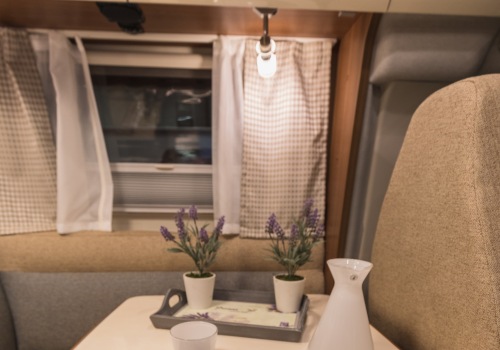
Besides choosing the best pot size and shape for your RV garden, invest in quality construction so the pots last for years. The only “cheap” planters I use are trays for growing lettuce.
Another essential tip is not to overdo it. Start with one or two plants and test it out for six months or a year.
You may love RV gardening and slowly expand your plant selections, but remember you’re still living in a camper, and space is always at a premium.
I have ten planters of various sizes. I can fit this amount inside my RV for travel or freeze protection. You’ll also need to leave space for a bin to hold your gardening supplies.
Best Pots for RV Gardens
I prefer self-watering glazed clay, thick plastic, or fiberglass pots that keep the soil from drying out too fast but aren’t overly heavy. Use square pots when possible to help prevent tip-overs during travel.
I am a fan of the stackable planter tower, but I find you don’t want to go too high if you often move campsites. You need to ensure you have space to spread out the pots in your RV interior or storage compartments once you unstack them for transport.
Best Soil for Container Plants
Always use lightweight potting soil to reduce strain when moving pots about and to avoid overloading your RV. A quality potting mix is best for quick root development as it’s not too dense.
Don’t bother with a potting mix that includes a fertilizer. The bags cost more, but you’ll still need to pay for fertilizer once the ingredients wear out in a few months.
Best Fertilizer for Container Plants
I can’t say enough about how well Joyful Dirt organic fertilizer works on all my plants. The size is ideal for RV storage restrictions, and it’s easy to order and have shipped to your location when you get low.
You may learn through trial and error that another type of fertilizer works best for your plant selection and weather conditions, so don’t be afraid to test out several until you find the perfect fit.
Pollinator for Veggies and Fruits
A manual pollinator tool can ensure plants that need a boost from bees or insects for cross-pollination aren’t left out.
When flowers appear on your vegetable or citrus plants, it’s easy to use the pollinating tool to ensure the pollen spreads around so more fruits can develop.
Self-Watering Bottles for Potted Plants
RVing is about experiencing the local culture, not tending to your garden 24/7. I love using the HydroSpike Drippers or a similar product to ensure my plants are getting the water they need when I’m out and about enjoying life.
You only need to attach a bottle to the top; it’s that simple. I also like repurposing my empty rum bottles by using terra cotta watering spikes in the same way.
Plant Covers for Weather Protection
Lastly, you must be ready to cover your plants on chilly nights. I keep various sizes of plant cover material that compacts nicely for storage but easy to pull out and wrap plants to keep them from freeze damage.
Tips for Secure Plant Storage and Travel
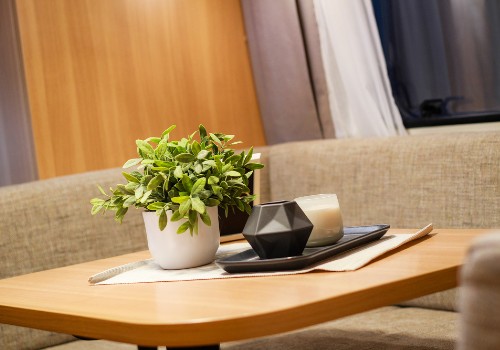
Moving your garden from campsite to campsite doesn’t need to be a mess. I find that the best solution for the secure movement of pots inside your recreational vehicle is to use tip-resistant planters in combination with tension shower rods.
For example, I move my plants by placing them in my shower stall and within a small nook in my bathroom. I pack my pots in these areas as tightly as I can, add a tension rod at the bottom against the pot edges, and add another higher up to support any tall foliage.
As long as you have a wall on either side (even in basement storage compartments), this technique works better than any other method I tried over the years. Take the time to measure where you plan to transport your plants and have four or so rods on hand to corral your pots so they don’t slide around when you drive your camper to a new destination.
Don’t forget to lay down some plastic under your pots if you’re concerned about dirt or water damage to your camper flooring. I lay down large trash bags that I reuse for my RV garbage.
In Summary
You don’t have to forgo gardening while traveling full-time in a recreational vehicle. Even small motorhomes or travel trailers have space for a plant or two.
You also don’t need to wait for long-term camping situations to begin your garden. Once you make one visit to a nursery or home improvement store, you can start planting right away.
Gardening is beneficial for the soul and stress levels. Join in this small but growing RV gardening community by using the information above to get planting!
Mobile Garden in a Class C RV? Yes! (Video)
"Man cannot discover new oceans unless he has the courage to lose sight of the shore."
-- Andre Gide

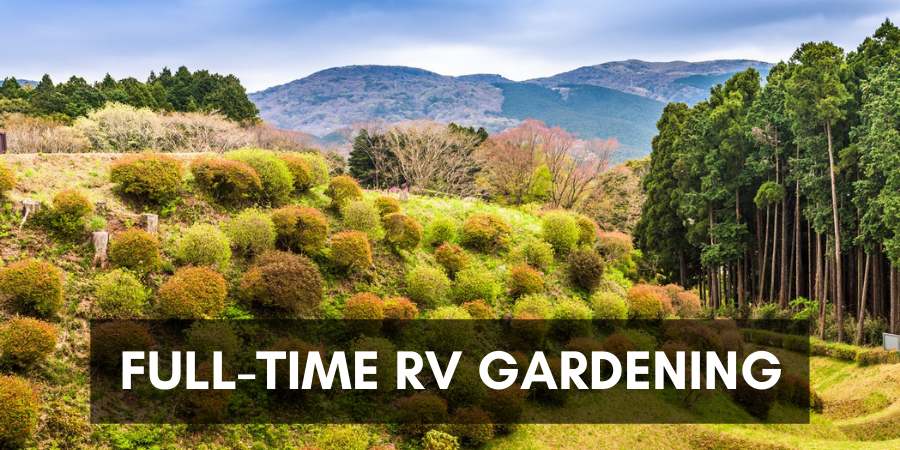

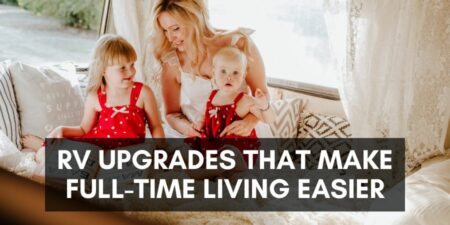
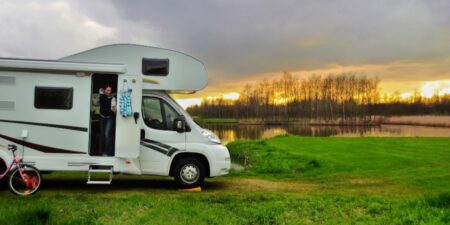
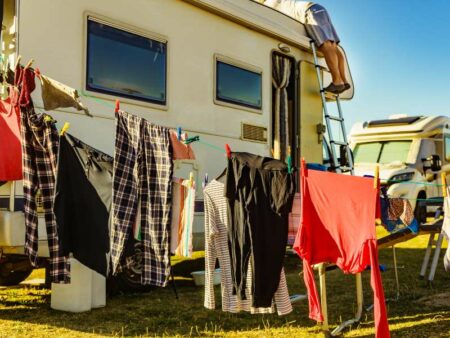
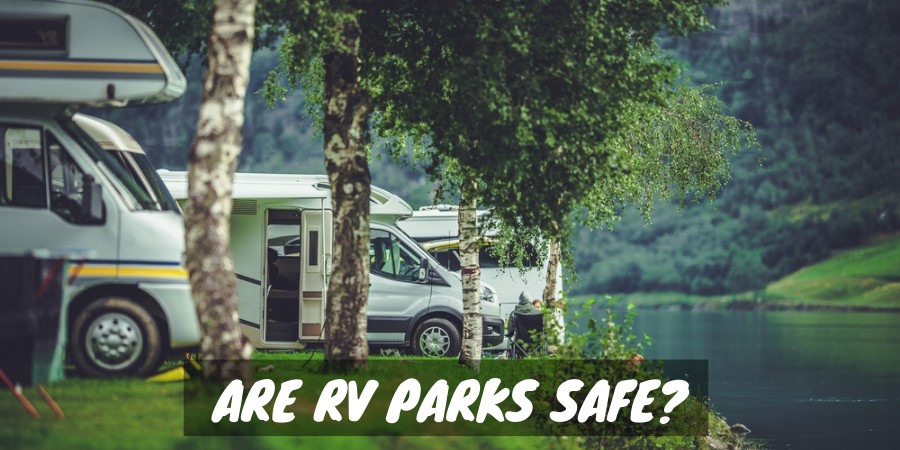
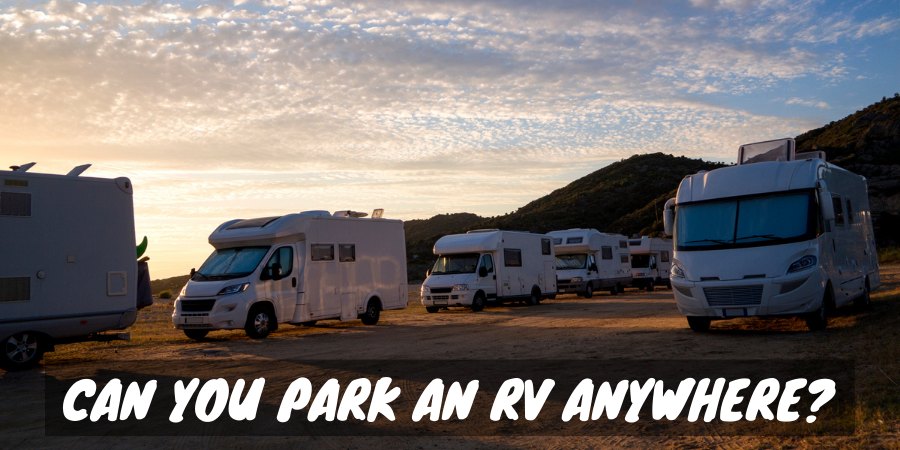

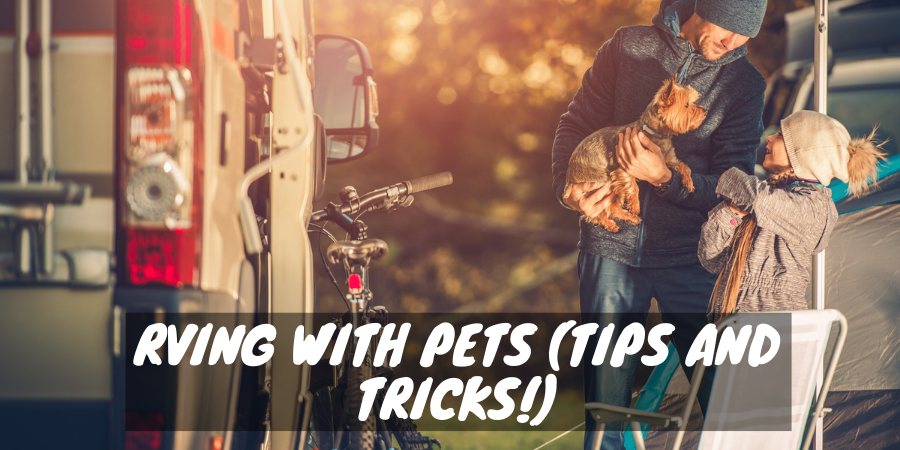
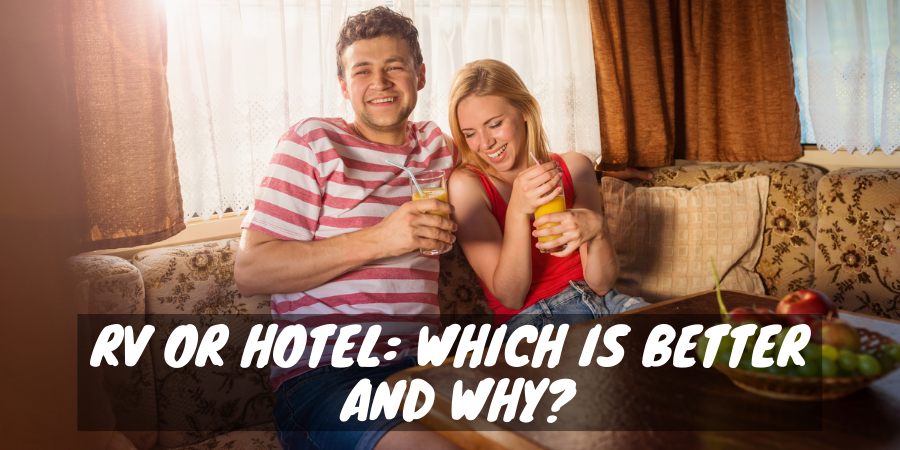
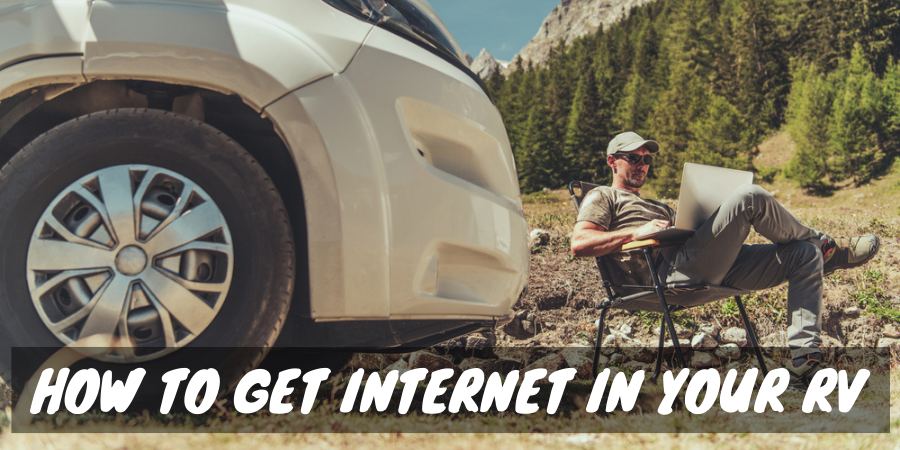
I used to live off wild black berries at a local RV park. If you can’t find the time to make your own garden… let nature do it for you. 🙂